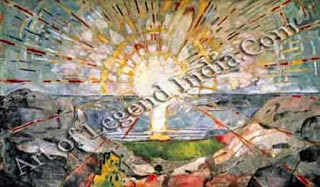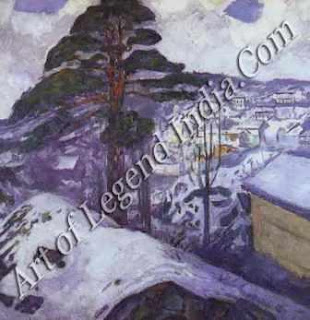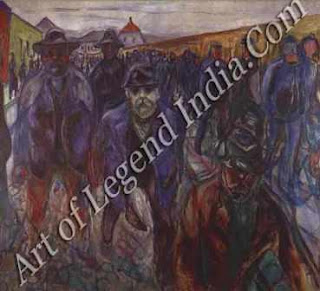Norwegian Great Artist - Edward Munch Painting Gallery
Posted by
Art Of Legend India [dot] Com
On
10:30 PM
Munch
was one of the key artists in overthrowing the idea that painting is concerned
fundamentally with imitating natural appearances. He depicted man's inner life
with an intensity that at times approached frenzy, and his greatest works treat
overpowering emotions such as fear and sex (these two often combined) with unprecedented
psychological conviction and subtlety. The Scream is the most famous of all his
works and the prime example of how he abandoned naturalism to gain emotional
impact, and works such as Puberty and Anxiety show how poignantly and
eloquently he portrayed the mental conflicts that beset mankind.
After
he recovered from a nervous breakdown in 1908, Munch's work became much less
introspective. He painted the working people of Norway with great vigour, his
landscapes show a new love of Nature, and in his murals for Oslo University he
proved himself one of the most glorious decorative artists of the 20th century.
This
painting, of which Munch made several other versions, was inspired by his
childhood experiences of sickness and death. Detail is reduced to a minimum,
and the eye is immediately drawn to the figure of the child whose pale face contrasts
with her red hair. We see both the yearning in the child's eyes and the
mother's pain.
The
awakening of sexual feelings was one of Munch's recurring themes. Adolf Paul, a
member of Munch's circle in Berlin, described the work in progress: 'On the
edge of the bed a naked girl was sitting. She did not look like a saint, yet
there was something innocent, coy and shy in her manner . . . these qualities
prompted Munch to paint her.'
'One
evening', wrote Munch, 'I was walking along a path, the city on fjord below. I
felt tired and ill. . The sun was setting and the clouds turning blood-red. I
sensed a scream passing through Nature; it seemed to me that I heard the
scream. I painted this picture, painted the clouds as admit blood. The colour
shrieked.'
In the
1902 Berlin Secession exhibition, Munch hung a series of his paintings around
four walls of the entrance hall to form his Frieze of Life. Anxiety hung on the
same wall as The Scream, a wall representing 'Fear of Life'. 'There was a
symphonic effect', wrote Munch, 'it made a great stir a lot of antagonism and a
lot approval.
This is
one of the pictures that made up Munch's Frieze of Life, an ambitious series of
works that never had a definitive form. 'The frieze is conceived', he wrote,
'as a series of paintings which together present a picture of life. Through the
whole series runs the undulating line of the seashore. Beyond that line is the
ever-moving sea, while beneath the trees is life in all its fullness, its
variety, its joys and sufferings.' Here the dancing figures represent physical
desire, but in the midst of passion there is loneliness, and the mournful
figure on the right suggests the transitoriness of all feelings.
Munch's
huge murals in the Great Hall of Oslo University were the greatest public
commission of his career and he responded with work of inspired boldness. The
murals represent the powerful forces of eternity, and here the sun is portrayed
as the source of life, its rays illuminating the sea and the rocky landscape of
the Kragero fiord.
When he
returned to Norway in 1909, after living mainly in Germany since 1892, Munch
spent much of his time at Kragero and he painted some splendid pictures of its
rough coastal scenery. This is perhaps the most monumental of them, the
vigorous composition dominated by the magnificent form of the pine tree.
This is
generally regarded as the most commanding of the series of pictures of workers
that Munch painted around this time. Although he was not a politically militant
artist, he identified strongly with the working class. He must have been
familiar with such scenes since his youth in Grunerlokka, when he lived near a
large sailcloth factory.
Munch often reworked his compositions over a
long period and he had painted a similar picture 40 years earlier, although
here the colours have a new electrifying quality. Figures standing on the
seashore were one of his favourite themes, suggesting the insignificance and
insecurity of man against the magnitude of Nature, and often conveying a sense
of isolation and melancholy.
Writer - Marshall Cavendish
Subscribe to:
Post Comments (Atom)

.jpg)


















0 Response to " Norwegian Great Artist - Edward Munch Painting Gallery"
Post a Comment